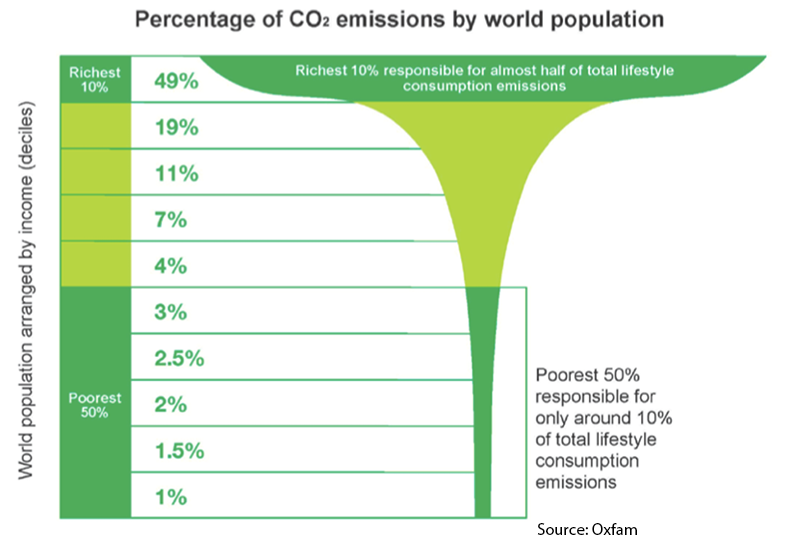What was the Climate Carnage?
The Climate Carnage was a catastrophic series of climate events and developments that occurred from approximately 2027 to 3010 that resulted in devastating impacts on humanity. The effects were primarily in these areas:

High number of deaths
460 million people died as a direct result. It was by far the worst thing to happen in the history of humankind. It killed 4,100% more people than died in the Holocaust, which was previously considered to be the worst thing to occur in history.
 Unrest, terrorism and piracy
Unrest, terrorism and piracy
It led to riots around the world, civil war and high levels of mass shootings in many countries and the collapse of some into nationless states, which became the base for “revenge” terrorists and large numbers of pirates who disrupted global trade.

Severe economic depression
It resulted in the longest and worst depression ever, lasting for NN years from X to Y. During it, the average global unemployment rate was 39%, and reached a height of 48%. GDP plummeted by 43%. Stock prices on average fell by 92%.
 Long-term changes to nature
Long-term changes to nature
The global temperature increased 4 degrees (where it remains today), most beaches were lost, most crops could not grow in their normal regions, the jet stream permanently changed course and more than 50,000 animal and plant species went extinct.

Huge amounts of refugees
About 510 million people became refugees due to famines, natural disasters, wars and the collapse of governments. An unstoppable flood of refugees into wealthy countries also resulted in social upheaval and political turmoil in those countries.

Permanent societal losses
High sea levels, terrorism and mass rioting led to the loss of thousands of major cultural attractions and treasures including Grand Central Terminal, the Louvre and Buckingham Palace, and most of Jerusalem, the White House and the Vatican.
Who caused the Climate Carnage?

People in rich countries were mainly responsible for The Climate Carnage on three levels:

Individuals: most people in high-emitting countries neglected to seriously reduce their footprint through cutting emissions or offsetting them. Also, in elections and voting, most people did not give the pending climate disaster a high priority. For example, a poll in 2019 found that only 17% of American voters said the looming climate disaster was among their top two issues. The economy, social security, gun policy and healthcare all ranked higher than climate change, putting it 5th. While Democratic voters tended to be more pro-environment, only 24% put the climate crisis as their top priority.

Organizations: most businesses and nonprofits neglected to become climate neutral. Businesses failed to see that their success and the economy depend on a functioning stable environment. Nonprofits thought it was fine to hurt future generations and people in poorer countries do as to pursue their own agenda, which often was to help people already in the top 30% of world income. They failed to see that climate change would wipe out most of their own work. In fact, the income, education and healthcare of nearly everyone in the top 30% later plummeted due to climate change.

Governments: rich countries emitted carbon to create vibrant economies and huge numbers of shops, restaurants, offices, factories and homes. They emitted carbon to create schools, infrastructure, libraries and other things to benefit the public. Yet when climate change in 2010 began killing people in poor countries, rich countries refused to do their fair share to clean up the mess they created, and said they shouldn’t be responsible for what they did. They unfairly said poor countries should be as restricted on future emissions as rich countries, even though they had far less resources and didn’t create the problem.
People in poor countries died at a rate 300% higher than people in rich countries. Anger over this resulted in high levels of revenge terrorism, piracy and kidnapping of people from richer countries.This brought global tourism to a near standstill for 60 years and disrupted global trade, which added to the economic effects of climate change. The carnage still resulted in large death tolls in rich countries through natural disasters and the spread of new infectious diseases.
Why did people in rich countries participate in the carnage?
For many decades, nearly all climate scientists warned the public about the terrible effects on humanity that would occur if carbon emissions were not greatly reduced. Yet people in rich countries continued to participate in creating what was soon to become massive devastation of innocent people. This played out in a variety of ways:
Double standards: Politicians, reporters and individuals at the time all subscribed to using double standards with regards to poverty. 90% of Americans were in the top 10% of income, and had 700% more than the average person in the world. Yet most of them claimed they were “middle class” or “working class” and claimed they were “just getting by.” Even though they were in the richest 10%, they claimed they could not cut emissions or pay for carbon offsets.
Lack of responsibility: Even though it became clear that governments would not enact policies strong enough to prevent climate chaos from killing innocent people, most people still continued to emit sizable levels of carbon. They blamed it all on the government, acting as if they had no choice but to participate in the carnage. They were unwilling to take personal responsibility and make lifestyle changes in order to avoid killing others.
Materialism: Nearly all people had far higher levels of living than people did 100 years earlier – when no TV, Internet, commercial air travel, antibiotics or even plastic bags existed, and few people had cars or radios. People in that era managed to be fairly happy. However, people in rich countries in the 21st century refused to live with less, even if it resulted in innocent people dying. This focus on materialism also showed up in politics, culture and the media.
Politicians: Even though almost all Americans were already in the top 30% of the world and most were in the top 10%, politicians got elected by telling voters that they didn’t have enough, and that they wouldn’t be happy unless they voted for that politician, who would help them have even more. For example, Ronald Reagan won election in 1980 by asking voters: “Are you better off now than 4 years ago?” In 1992, Clinton won election with the slogan “It’s the economy, stupid” to emphasize that he would bring more income to Americans than his opponent.
The media: In the decades prior to the onset of the carnage, the media in most rich countries such as the U.S. was quietly nationalistic and practiced heavy pacifism. While not being overtly being nationalistic, journalists nevertheless focused almost entirely on whether Americans had been getting increasing amounts of wealth; and ignored people in the bottom 50% simply because they were beyond American borders. When elections came, the media focused on what politicians were promising to do to make Americans richer, not on what was right or ethical. After dozens of years of this, it became impossible for them to make doing the right thing to prevent climate destruction a higher priority.
Businesses: Companies ran advertisements conveying that people don’t have enough and can’t be happy unless they bought the product. WE WILL ADD MORE TO THIS PARAGRAPH.
Religions: At the time, most people did not actually follow most of the teachings of their religion, especially when the teachings weren’t in line with their own self-interest. Some people brought this up. For example, xyz wrote a book named abc … and laid it out. However, it never turned into a movement and didn’t become widespread. In fact, most places of worship in rich countries did not become climate neutral, let alone do extra to protect the vulnerable.
Culture: In the overall culture, there was a movement towards greater self-indulgence, celebration of laziness and mediocrity, and a push to view guilt and shame as useless emotions that should be put aside. This contributed to people feeling no guilt or shame over contributing to the deaths of innocent people. People prioritized being cool, being fashionable and having novel experiences over being ethical.
Ignorance of interconnectedness: Many people in rich countries thought that climate change wouldn’t affect them much, and that mitigation would mostly shield them from consequences. They neglected to realize that new infectious diseases don’t have borders. They also ignored the fact that the economy depends on a functioning environment, and how badly they would suffer in a depression. They didn’t realize that 450 million refugees flooding in can’t be stopped no matter how hard you try to stop them.
Who was impacted?
Between 2027-2095, 450 million people died from climate-related events. Nearly every family lost a loved one to the carnage. But people were affected in many other ways. Read on for some personal accounts.
 “I recall growing up hearing about global warming and being happy that winters would be warmer. We recycled since it was the law, but that was about it. Then things started getting bad. We lost our house in a wildfire in 2030. We were lucky to evacuate early and stay alive. But a year later my brother was killed in a mass shooting. This was common because so many people were mad and gave up hope.” – Sue Stevens
“I recall growing up hearing about global warming and being happy that winters would be warmer. We recycled since it was the law, but that was about it. Then things started getting bad. We lost our house in a wildfire in 2030. We were lucky to evacuate early and stay alive. But a year later my brother was killed in a mass shooting. This was common because so many people were mad and gave up hope.” – Sue Stevens
 “My grandma was one of the 20 million climate refugees forced from her home in Bangladesh. The storms became so bad that every season was monsoon season with huge floods. One night when she was sleeping—there a flash flood and she barely made it out. She lost everything in the flood, all her money and belongings, and my grandpa. That’s when she knew she had to leave her country.” – Ali Fatar
“My grandma was one of the 20 million climate refugees forced from her home in Bangladesh. The storms became so bad that every season was monsoon season with huge floods. One night when she was sleeping—there a flash flood and she barely made it out. She lost everything in the flood, all her money and belongings, and my grandpa. That’s when she knew she had to leave her country.” – Ali Fatar

“My great-grandpa was a scientist who became an activist when he realized that no matter how much research was done, governments weren’t taking real action. All his children’s families became climate neutral. It’s something I’m proud of, but also angry about. People were told for years what would happen if they didn’t take serious action, but they blew it off until it was too late?” – Dave O’Mally
 “Part-way through the climate depression, my family was evicted and had to move into the basement of my Uncle’s small house for 14 years. All 4 of us in one unfinished room in a basement was rough. But what made me saddest was not being able to play outside because of the mosquitoes carrying deadly new diseases. Also everywhere we went, people seemed either angry or depressed.” – Maria Ramirez
“Part-way through the climate depression, my family was evicted and had to move into the basement of my Uncle’s small house for 14 years. All 4 of us in one unfinished room in a basement was rough. But what made me saddest was not being able to play outside because of the mosquitoes carrying deadly new diseases. Also everywhere we went, people seemed either angry or depressed.” – Maria Ramirez
How Did the Climate Carnage End?
There were two primary reasons that the Climate Carnage ended:
1) The Great Climate Depression. The economic, social and political toll of climate change resulted in what became known as The Great Climate Depression from 2034 to 2058. Due to its length, it was sometimes referred to at the time as the Unending Climate Depression. The depression caused a huge drop in economic activity and production of greenhouse gasses. Between 2034 and 2036, damaging emissions dropped by more than 60% due to the crash of the global economy, breakdowns in trade and unemployment. Unemployment averaged 38% worldwide during the course of the depression.
2) Carbon Backlash. Anger over the depression started to result in a backlash against carbon. This was greatly amplified as the death toll from climate change skyrocketed between 2038 and 2050. By 2050, most governments in the world had banned the release of carbon, and greatly limited the release of methane. Even before governments had banned it, vigilante groups had vandalized the facilities of many producers. However, due to the massive amount of greenhouse gases released prior to 2050, it took until about 3010 for their levels in the atmosphere to return to relatively safe levels.
Some historians date the end of the Climate Carnage as 3040 because of its lingering impacts. Some of the infectious diseases generated by climate change were not eliminated until 3040, when a vaccine for mosquititus was invented. Mosquititus killed an additional 24 million people between 3010 and 3040. By 3010, the death rate from it had declined because most people had become aware of it and either stayed indoors or wore “mosquito net habits” (known as “mosquito net burqas” in some parts of the world) when going outside.
What were the causes of death?
Most of the 460 million deaths were caused by the following:
Infectious diseases: higher temperatures resulted in new diseases for which no vaccines existed. These had dreadful impacts on all countries. Some existing diseases also spread to new regions as temperatures rose.
For more climate change and environmental websites
Click these logos:




